In the search for the best cordless stick vacuum, let’s try to compare the Roborock H7 and Dyson V15 for today’s article. My experience shows that both have wonderful performances, but the V15 is somewhat better.
Dyson V15 has phenomenal suction power, 240AW in boost mode. The machine performs very well, no matter the surface. It can handle dirt of different sizes with ease, even full-size Froot Loops. In addition, the device is also equipped with a piezo sensor to optimize the battery life.
Roborock H7 is a great choice for someone who is seeking a compact vacuum. It weighs only 3.2 pounds and accounts for a pretty small space in your house. In particular, you can use it as a bagless or pocket machine. Besides, it also cleans carpets effectively and is quite quiet.
Roborock H7 vs Dyson V15: Comparison Chart




Roborock H7 vs Dyson V15: Differences
After weighing the differences between these two machines, I concluded that Dyson V15 won 2:1 and tied 1 against Roborock H7. The V15 outperforms its opponent with its suction power, cleaning performance, accessories, and utilities. To learn more details, please read the breakdown below.
Cleaning performance
The winner: Dyson V15
Performance on hard floors
Dyson V15 performs excellently on hard floors. In my cleaning tests, this machine picked up all sizes of debris without struggling, even full-size Froot Loops. When buying the vacuum, users are provided with two main cleaning heads, a multi-surface and a slim fluffy.
The slim fluffy cleaning head is specifically designed for flooring. Its soft brush roll allows you to vacuum hard floors without scratching them. It also has a laser on the side, which can illuminate the small particles on the floor that are invisible to the naked eye so that you can clean your area more thoroughly.
You can also use the multi-surface nozzle to deal with hard floors. There is no need to change the cleaning head when moving from carpets to hard floors since this nozzle works well on a variety of surfaces. This cleaning head includes adjustable gates at the front, which makes it so much better for picking up larger debris on both hard floors and carpets.
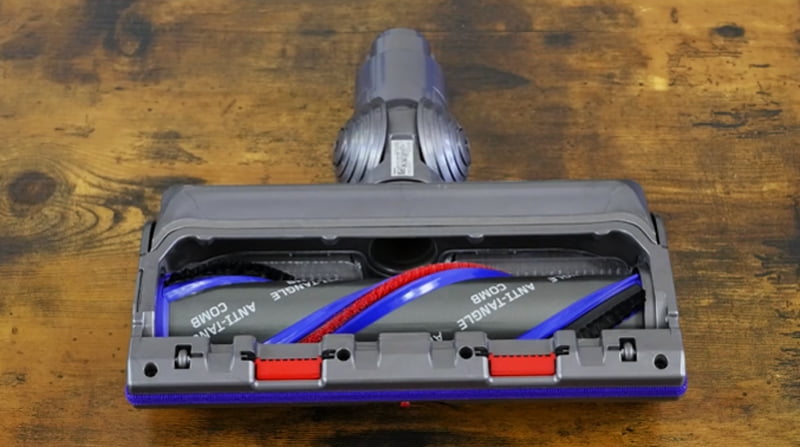
Meanwhile, Roborock H7 only has one cleaning head. This device does a great job of picking up fine and small debris. With bulkier materials like cat litter, you may need a few more passes to suck all of it. Since this machine doesn’t come with any height adjustment feature, it is pretty hard for you to vacuum large debris like breakfast cereal and Froot Loops.
Performance on carpets
Dyson V15 delivers amazing performance on carpets, even high-pile and shag carpets. Its multi-surface cleaning head uses a dense and stiff bristle brush roll, which allows the unit to dig into the carpet and pull out more dirt than at every pass. Additionally, it also offers three settings for you to adjust gates at the front depending on what surface you are cleaning.
When vacuuming on thick carpets, you should choose the highest setting, meaning all the gates will be fully open. This releases suction and allows the machine to roll more easily over the carpet. Rest assured that you won’t have to sacrifice much suction power, and your carpet will definitely still be cleaned. Also, the cleaning head doesn’t jam with hair or fiber.
Roborock H7 is also a great choice for carpeting. On low-pile carpets, this vacuum can deal with all fine and small debris with only one or two passes. My experience shows that this machine seems to vacuum better on carpets than on hard floors. However, it has trouble with washable rugs, which my cats often play on. Although I have set the machine to Auto mode, it sometimes acts like a jam.
Pet hair performance
Overall, both machines are good options for pet owners. They all do an impressive job of picking up pet hair on hard floors as well as low-and high-pile carpets. Besides vacuuming, their filtration system can also trap allergens like pet dander and reduce odor.
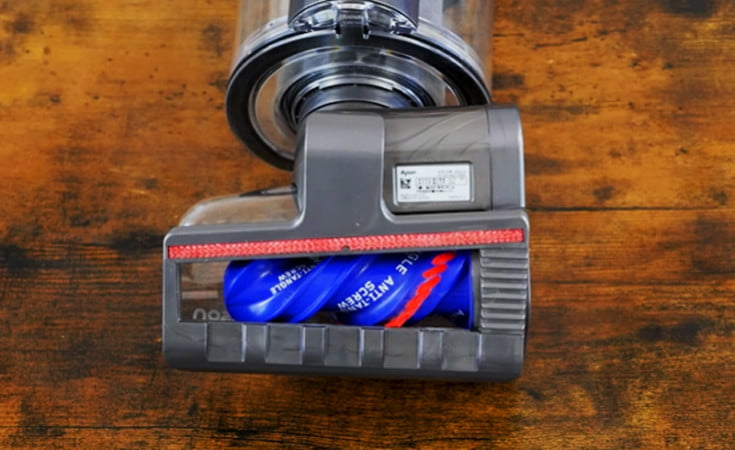
In addition to the main cleaning heads, each machine is also equipped with specialized brushes and tools for lifting pet hair from upholstery furniture.
The biggest difference is that the Dyson V15 can resist tangles, and the Roborock H7 can’t. The multi-surface cleaning head of the V15 has a series of vanes that act like a comb to clean the hair wrapped around the roller. Moreover, it also has a motor-driven hair screw tool, which is designed to be extremely compact for picking up long hair and pet hair in small spaces with an anti-tangle conical brush bar.
Roborock H7 has no anti-tangle function, so when vacuuming a lot of long human hair, the machine often clogs. Its cleaning head’s brushroll isn’t removable, so it’s hard to clear tangled hair.
Suction power
Dyson V15 is outstanding with its phenomenal suction power. This vacuum features a new digital motor called the Hyperdymium that spins at up to 125,000 revolutions per minute. In boost mode, the maximum output of V5 can be up to 240 AW. In addition, the machine is equipped with the latest cyclone technology to help trap smaller dirt particles. According to Dyson, the V15 can deliver up to 100 liters of airflow per second, which is a good specification compared to other upright and stick models on the market.
Meanwhile, the maximum suction power of the Roborock H7 is only about 160 AW, only about half of the maximum of the Dyson V15. This also explains why the H7 has a hard time picking up dirt in cracks.
Dirt bin and filtration
The winner: Roborock H7
Dirt bin
Dyson V15 is a bagless vacuum cleaner, which means it stores all picked-up dirt and debris in a dirt container. The container is made of clear plastic so that you can check how full it is at any time. Its capacity is about 0.76L, not really big but enough for not emptying too frequently. Also, it is easy to empty with just a button. When you push the release button, the bin will slide down, cleaning the shroud as it goes simultaneously, and the bin base will open.
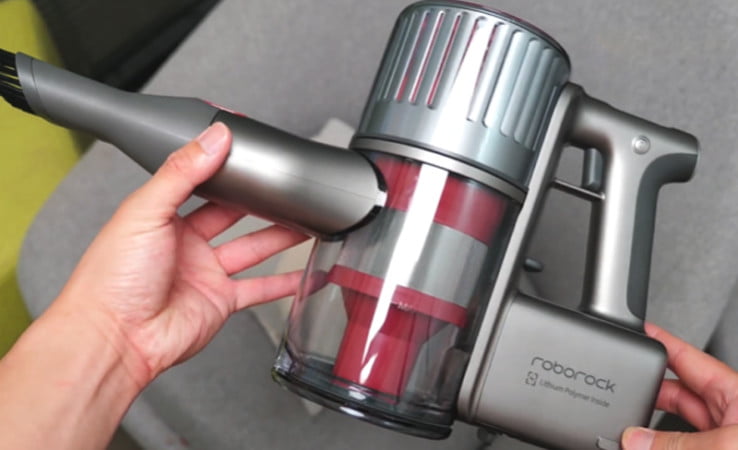
As for the Roborock H7, you have two options: bagged and bagless. With the bagless option, the dust vacuumed will be retained in a dirt container, similar to the one of the Dyson V15. With the bagged option, the unit comes with two dirtbags. This second option allows you to keep the dust bin spotlessly clean as well as prevent the spread of allergens. These dust bags automatically close when removed to force the dirt to stay inside from escaping. Therefore, the dust won’t fly back into the air when emptying the trash. For those with allergies or breathing problems, this is a real convenience.
Filtration
Dyson V15 features a whole-machine filtration system, which can capture 99.97% of particles as small as 0.3 microns, such as dust, bacteria, mold, pollen, pet dander, etc. Dyson doesn’t mention that this is HEPA standard, but it is still pretty effective at trapping allergens. The system consists of many layers of filters to ensure that the air is filtered as thoroughly as possible. The filter is located at the rear of the vacuum. It is easy to remove and can be rinsed with cold water for reusing. Therefore, it does not cost you to buy a new one unless it is damaged.
Roborock H7 uses a filtration system with five filter layers, including a HEPA filter. The HEPA filter is the second layer of filtration, which captures 99.97% of particles down to 0.3 microns. This system is designed to provide high-efficiency air filtration and trap a wide range of airborne pollutants. All the filters are washable and reusable.
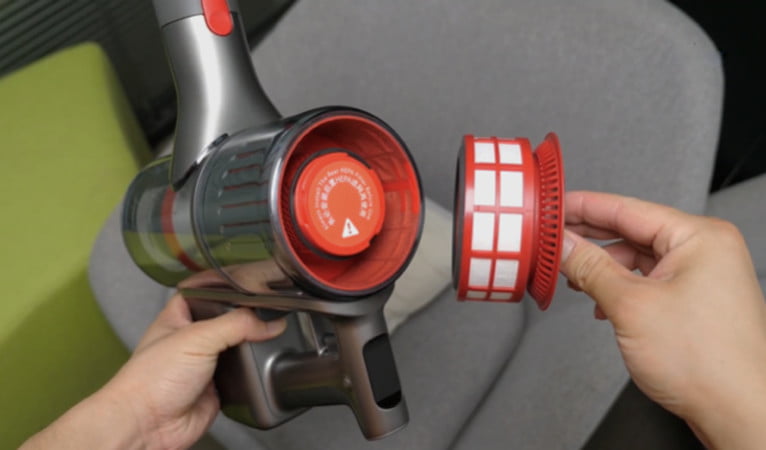
Design and convenience
Tie
Maneuverability
These vacuums have good maneuverability. Their first advantage is that they all have a compact design. Dyson V15 weighs about 6.8 pounds, while Roborock H7 weighs only 3.2 pounds, which is super lightweight. They only account for a very small area for storage and are easy to carry everywhere.
The compact size and low profile nozzle allow them to easily move around furniture and get deeper into tight nooks and crannies. Their main cleaning heads can rotate at a fairly large angle, which boosts their maneuverability.
No cumbersome wires and also no limitation in cleaning range are their other advantages.
In addition, both machines feature handheld mode, which delivers more convenience for users to clean various locations in the home, such as stairs, furniture, windows, ceilings, and more.
Storage
Dyson V15 is easy to store. This vacuum comes with a wall mount, which allows users to store and charge the unit at the same time. Besides, it comes equipped with a wand clip to carry around two accessories, while you can store two other tools on the dock station.
Roborock H7 is even more convenient. Its wall mount and attachments both have built-in magnets, allowing users to attach all attachments to the wall mount. In addition, you can also store attachments on any surface, as long as it is magnetic, such as the refrigerator door.
Noise level
According to what I have measured, both machines are quite quiet. They almost have the same average amount of noise, around 70-71 decibels. This noise level is equivalent to the sound of a normal conversation and is at a safe level for your hearing. You can still vacuum while talking on the phone without any problems.
Battery
According to Roborock, the H7 is powered by a massive LiPO battery with up to 90 minutes of battery life. The lithium Polymer battery (LiPO) is a rechargeable battery that uses polymer electrolytes. The advantages of this battery type are a large energy reserve, low cost, lightweight, and low discharge.
In fact, the H7 can run for 82 minutes in Eco mode with no attachments. When the cleaning head is attached, the machine can run for 33 minutes in standard mode and 9 minutes in turbo mode. In particular, this device only takes 2.5 hours to fully charge, faster than many other devices at the same price. However, the disadvantage of LiPO batteries is that they are heavy and flammable.
Meanwhile, Li-ion batteries power the Dyson V15, with 60-minute battery life. Li-ion batteries store less energy than LiPO batteries and are more expensive, but in return, they are lighter, more durable, less leaky, and more impact-resistant. The V15 still has nearly half its battery left after cleaning a 325 square meter house. Depending on the cleaning mode, the battery life also varies. In boost mode, the device only runs for less than 10 minutes.
In addition, the Dyson V15 takes a long time to charge, about 4 hours. Fortunately, the battery is removable. I recommend you buy an extra battery for backup, ensuring the cleaning process is not interrupted.
Charger
There are two ways to clean the Dyson V15. Besides charging the device with the charging dock, you can also plug the charger directly into the vacuum head. Additionally, you can also detach the battery and charge it separately.
As for the Roborock H7, the only way to clean it is to insert the device into the charging dock. Its battery is built into the vacuum and cannot be removed or replaced by users. If you need to replace the battery, consult a technical professional or Roborock customer support.
Utilities
The winner: Dyson V15
Digital display
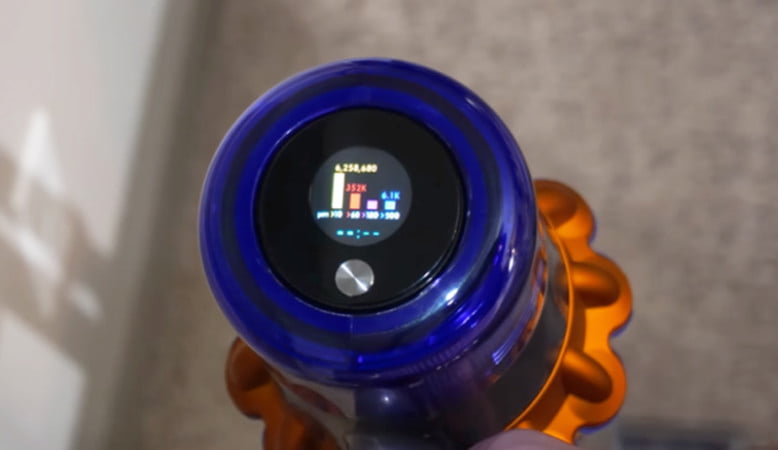
Both machines feature a digital display, but each machine uses a different type of display.
The Dyson V15 comes with an LCD screen, which displays parameters such as three cleaning modes, battery percentage, time as well as the amount and size of particles sucked in.
As for Roborock H7, the device uses an OLED screen. This screen shows information such as battery life, work modes, and child lock.
Piezo sensor
The Dyson V15 is equipped with a piezo sensor, which can adjust the vacuum’s suction power based on how much dirt it detects. When a high dust concentration is detected, the reactive suction power is activated to increase the capacity automatically. When the dust concentration returns to normal, the suction power will decrease. Therefore, when using Auto mode, the battery life will be significantly saved.
Besides, this sensor is also used to count the number and size of particles vacuumed. All the information will be displayed on the LCD screen. You may feel this feature is not too necessary, but I believe that once you experience it, you will have a different opinion.
Quick Rundown Of Dyson V15
- The most powerful intelligent cordless vacuum.¹ With laser illumination.
Quick Rundown Of Roborock H7
- Powerful Long-Lasting Cleaning. Clean on and on with a 90 min runtime without swapping batteries and recharging from empty in only 2.5 hours.
- Intense Suction. 160 AW HyperForce suction with certified Constant Suction Power cleans intensely and effectively at all times.
- Crisp Clean Air. Five-stage HEPA air filtration system keeps dust from spreading around your home.
- Light and Easy. Lightweight for easy maneuvering, with OLED screen for real-time updates.
- Easy Accessory Access. Keep accessories in easy reach, and store them more easily on the wall-mountable dock with MagBase.
Product Videos
Related Articles to Dyson V15
- Triflex HX2 Vs Dyson V15: Best Cordless Vacuum? $ 600$
- Karcher VC7 Vs Dyson V15: Find Out The Better Pick For You!
- LG CordZero Kompressor Vs Dyson V15: Compare The Two Premium Stick Vacuums
- Vorwerk Folletto VK7s Vs Dyson V15 Honest Review: Versatile & High-Performance Vacuums
- Miele Triflex HX2 Pro Vs Dyson V15: Battle Between High-end Stick Vacuums – Which Is Better?
- Samsung Jet 75 Pet Vs Dyson V15: Determining The Best Vacuum Cleaner
- AEG ULTIMATE 8000 vs Dyson V15: A Head-To-Head Comparison
- Dyson V15 vs Rowenta 15.60: Which Is The Most Powerful Cordless Stick Vacuum?
- Vorwerk Vk7 vs Dyson V15: Which Will Win With A Whopping ~$200 Price Gap?
- Philips XC8349/01 vs Dyson V15: Who Should Buy These Powerful Cordless Stick Vacuum Cleaners?
- Lupe vs Dyson V15: 2 Powerful Vacuums – Which One Makes A Smatter Investment?
- Shark IZ320UKT vs Dyson V15: Are These Vacuums Worth The Money?
- Bosch Unlimited 7 vs Dyson V15: Can Bosch Surpass Dyson? – Choose Your Perfect Vacuum!
- Kobold VB100 Vs Dyson V15: Vacuuming Power Showdown
- Samsung Jet 70 Pet Vs Dyson V15 Detect: Which Is Better For Whole-House Cleaning?
- LG CordZero vs Dyson V15: A Tough Comparison Between The Most Powerful Cordless Stick Vacuums
- Dyson V15 vs Bosch Serie 8: Can Miele Surpass Dyson In A Vacuum’s Faceoff?
- Dyson V15 Vs Outsize Cordless Vacuums: Staying With The Standard Or Extra Size?
- Samsung Jet 60 Vs Dyson V15: Discover The Best Vacuum
- Dyson V15 vs Philips 9000: Should You Invest In A Dyson Or A Wet-dry Philips?
- Karcher VC6 Vs Dyson V15: Which One Should You Opt For?
- Tineco S11 Vs Dyson V15: A Head-To-Head Battle Of Premium Cordless Vacuums
- Samsung Bespoke Jet Vs Dyson V15 Detect: Compare The Top-Notch Cordless Stick Vacuums
- Dyson V15 Detect Vs V11 Animal: Let’s Read to Choose the Better One!
- Dyson V15 vs Philips 8000: 2 Expensive Cordless Stick Vacuums – Which One Is Better?
- Xiaomi G11 vs Dyson V15: An Honest Comparison Review For Stick Vacuum Lovers
- Hoover HF 9 Vs Dyson V15: Best Cordless Stick Vacuum for Easy and Hassle-Free Cleaning
- Vax Blade 4 Vs Dyson V15: Detailed Review And Comparison
- Xiaomi V11 vs Dyson V15: Let’s Read To Find Out What Is The Better One!
- Dyson V15 Vs Samsung Jet 75: The Battle For The Best Stick Vacuum Crown
Related Articles to Roborock H7
- Roborock H7 vs Dyson V12: A Newest Head-To-Head Comparison
- Roborock H7 vs Samsung Jet 90: Honest Review and Detailed Comparison
References:
- Dyson V15: https://www.dyson.com/vacuum-cleaners/cordless/v15/detect/yellow-iron
- Roborock H7: https://global.roborock.com/pages/roborock-h7

Victor K. Giles is a leading consultant and expert in vacuum cleaner technology with over a decade of experience. As a mechanical engineering graduate in the University of Michigan, he specializes in product development, design optimization, and performance analysis. Victor collaborates with manufacturers and educates consumers, making her a sought-after guest speaker at industry events. His work has been featured in renowned publications, and he shares his expertise on his blog, “The Vacuum Teria”. Victor’s passion for cleaner, healthier living spaces drives his to help clients choose the best vacuum solutions for their needs.
